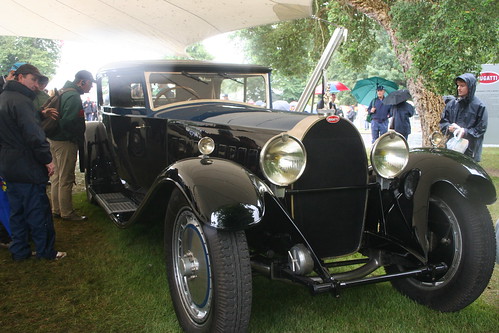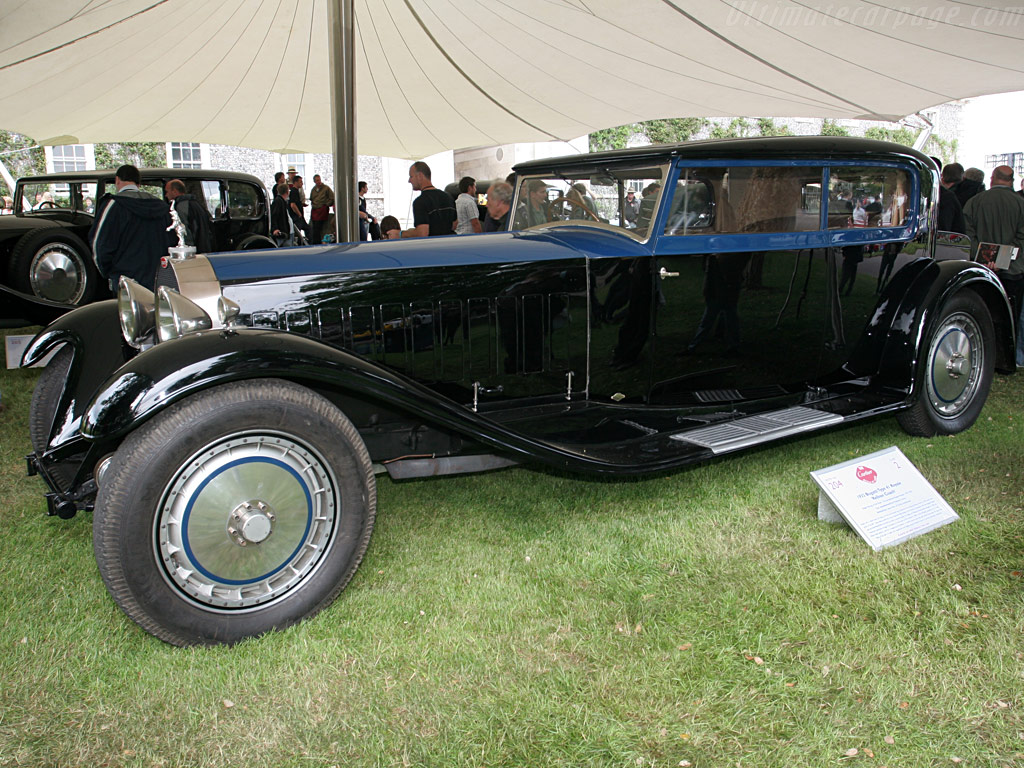Model history:Ever since he started building cars under his own name, Ettore Bugatti dreamed of creating the ultimate, no compromise luxury car. To that end, he started the development of an eight cylinder engine in 1913 and wrote in great detail about his ambitions in a letter to his friend Espanet. The project was cut short by the outbreak of war throughout Europe. Bugatti redesigned the engine and was used in the war to power airplanes. With peace returned to Europe, Bugatti continued to produce the four cylinder engined cars that had proven so popular before the war.
Although displacing well over seven times more than the Type 30/35 eight cylinder engines, the engine in the Type 41 followed the same design, just at a completely different scale. The in-line engine had a block cast in one piece with an integral cylinder, measuring a staggering 1.4 metres in length. Actuated by a single overhead, each cylinder featured three vertically mounted valves; two intake and exhaust. The dry-sump engine was fed by just one Bugatti designed Carburetor and sported two plugs per cylinder. The prototype engine had the promised displacement of around 15 litres, but for the subsequent production cars a slightly smaller displacement of 12.8 litre was chosen. |
| Add capti |
To allow room for the absolutely massive engine, Bugatti constructed a chassis with a wheelbase of 4.3 metres. Like most Bugatti's chassis, the Type 41's was a highly conventional ladder frame, suspended by live axles front a rear. At the front semi-elliptic leaf springs were fitted while the rear suspension featured the traditional Bugatti reversed quarter elliptic leaf springs. Operated by cables, the drum brakes followed the cars massive dimensions with a diameter of 18 inches. As with the successful racing cars, the one-piece aluminium wheels doubled as brake drums. While the Type 41 chassis was not the most advanced available, the meticulous finish was absolutely fantastic.
Equipped with a place-holder Packard body, the first chassis was completed in 1927. Despite its exceptional dimensions, the Royale impressed by its road holding capabilities and fabulously quiet ride. Ettore Bugatti had certainly succeeded in building the ultimate luxury car, but now came the difficult part; finding customers. The biggest obstruction was the high price Bugatti asked for the car. At the 1932 Olympia Show in London one of the chassis was offered for a staggering £6,500, which was twice as much as a the most expensive Rolls Royce. |
| Add capt |
Eventually only five additional Royales were constructed, which was well short of the 25 car run Bugatti had quietly hoped for. Only four of these found an owner; the first and last car produced remained in the hands of the Bugatti family for many years. Ironically none of the Royale's owners were royals and to this date none of the six Type 41s has ever been owned by a royal. Bugatti did manage to turn a profit out of the project by selling Type 41 engines to a train manufacturer. With the subsequent Type 46, 50 and 57 models, Bugatti did manage to conquer the luxury market.
Chassis:
Originally owned by the Bugatti family, the featured Type 41 Royale was the fifth example built. It was bodied by Kellner with a two-door sedan body, which easily seats four people. This was the car that was on display at the 1932 Olympia Show. After the second world war it was one of two Bugattis bought by Briggs Cunningham. It was retained by the family until 1987 when the car was offered at a Christie's auction. It sold for a staggering $8.7 million, which to this date is the highest price paid for any car at an auction. It was a smart investment as three years later it sold for almost twice as much to the Meitec Corporation in Japan. In recent years the car resurfaced and is frequently shown at events by Swiss broker Lukas Huni. It is shown above during the 2007 Goodwood Festival of Speed where it celebrated the Royale's eightieth anniversary along with four other examples. |
Bugatti Type 41 Royale Kellner Coach Specifications
| General specifications |
| Country of origin | France |
| Chassis number | 41141 |
| Numbers built | One of six Royales |
| Produced in | 1932 |
| Body design | Kellner |
| Engine |
| Configuration | Straight 8 |
| Location | Front, longitudinally mounted |
| Weight | 350 kilo / 771.6 lbs |
| Construction | cast-iron block and head |
| Displacement | 12.763 liter / 778.8 cu in |
| Bore / Stroke | 125.0 mm (4.9 in) / 130.0 mm (5.1 in) |
| Valvetrain | 3 valves / cylinder, SOHC |
| Fuel feed | 1 Bugatti Carburettor |
| Aspiration | Naturally Aspirated |
| Drivetrain |
| Chassis/body | body on ladder frame |
| Front suspension | live axle, semi-elliptic leaf springs, friction dampers |
| Rear suspension | live axle, quarter elliptic leaf springs, friction dampers |
| Brakes | cable operated drums, all-round |
| Gearbox | 3 speed Manual |
| Drive | Rear wheel drive |
| Dimensions |
| Weight | 3000 kilo / 6613.9 lbs |
| Length / Width / Height | 6000 mm (236.2 in) / N/A / N/A |
| Wheelbase / Track (fr/r) | 4300 mm (169.3 in) / 1600 mm (63 in) / 1600 mm (63 in) |
| Performance figures |
| Power | 300 bhp / 224 KW @ 3000 rpm |
| Torque | 785 Nm / 579 ft lbs |
| BHP/Liter | 24 bhp / liter |
| Power to weight | 0.1 bhp / kg |
| Top Speed | 160 km/h / 99 mph |















0 comments:
Post a Comment